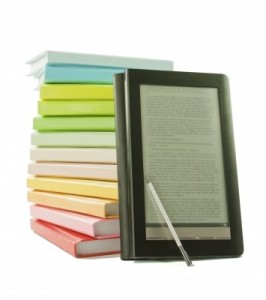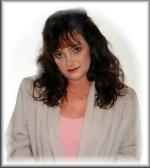A short intro to digital media for authors who haven’t got a clue
Guest Expert: Lynn Serafinn
 I’m a fairly techie person. I’m on the computer so much I might has well have a microprocessor implanted into my brain so I didn’t have to sit at my desk all the time. But although I’m pretty expert with the Internet, social media, WordPress, web pages, etc., there are two areas in which I’m a bit of a late bloomer. One is mobile technology (I’ll be talking more about that in a later issue). I only just got my first “smart” phone (a Blackberry) less than 6 months ago. And while I work with authors ALL the time, the second area to which I am admittedly a late bloomer is the world of digital books—eBooks.
I’m a fairly techie person. I’m on the computer so much I might has well have a microprocessor implanted into my brain so I didn’t have to sit at my desk all the time. But although I’m pretty expert with the Internet, social media, WordPress, web pages, etc., there are two areas in which I’m a bit of a late bloomer. One is mobile technology (I’ll be talking more about that in a later issue). I only just got my first “smart” phone (a Blackberry) less than 6 months ago. And while I work with authors ALL the time, the second area to which I am admittedly a late bloomer is the world of digital books—eBooks.
Actually, these two things (mobile technology and digital format books) are very, very much related, and if we authors do not have a clue about them, and how they work together, we are quite likely to miss out on half (if not more) of our potential book sales. In fact, my good friend Tony Eldridge from “Marketing Tips for Authors” recently became a #1 seller because of his digital book.
I used to think an eBook was just a PDF file that was pretty much a duplicate of your print book. And up until a few years ago, that was true. Then, along came the Kindle, and a whole new market opened up. But THEN, “smart” mobile technology, such as iPhones, iPads and so many other formats entered onto the scene. It’s a confusing quagmire of technology, and it’s VERY easy to get overwhelmed with the options.
So I thought I’d write a VERY basic introduction to some of the practical considerations for eBook creation and distribution for authors who are self-publishing.
Question 1:
Do you need to bother publishing your book in an electronic format if you have a print edition?
Answer:
ABSOLUTELY YES!!! Amazon actually sells MORE Kindle eBook sales than it sells print books! Can you believe I don’t even own a Kindle yet? What was I thinking? (I’m ordering one next month!)
Question 2:
What eBook formats are there? Which format should I use?
Answer:
There are many formats, but the two you should concern yourself with most are Kindle (a bespoke format from Amazon) and the ePub format, which is used by iPad and other companies.
Kindle is the big leader in eBook sales (having been around for almost 5 years now), but iPad is catching up with currently nearly a quarter of all eBook sales at last count. Also, the ePub format is compatible with many other mobile devices besides the iPad. You should use BOTH formats, as well as PDF.
Question 3:
Where do I have to go to set up accounts for an eBook?
Answer:
My suggestion is to use THREE: Amazon (for Kindle), Lightning Source AND Smashwords for other electronic formats. They all distribute to completely different channels (the only overlap I have found between LS and Smashword Kobo).
For Kindle, go to https://kdp.amazon.com/self-publishing/signin and get started. Be SURE to read all their guidelines before submitting anything. You don’t have to have an ISBN, but I think it’s a great idea to have one.
For Lightning Source, go to http://lightningsource.com. Download their list of “CoreSource” Fulfilment partners (there are probably about 60 of them, including MBS Books, Lulu, CyberRead, The Book Depository, Kobo and many others. They deliver eBooks in Adobe Acrobat ebook Reader, Microsoft Reader, and Palm eBook formats. You WILL need a new ISBN for your eBook version.
If you go to Smashwords at http://smashwords.com you’ll see their distribution partners on their home page as Apple iBookstore, Barnes & Noble, Sony Reader Store, Kobo and the Diesel eBook Store. Again, you don’t need an ISBN, but I think it’s a lot better to use your own, as it associates your book with YOU as a publisher, and not with Smashwords.
Question 4:
How do I get my book into digital format for Kindle and ePub? Do I just upload my PDF of my print book?
Answer:
Nope. Each company has their own formatting guidelines and it’s EXTREMELY important you follow them. If formatting is not your “thing” someone can help you prepare your book for digital format. Smashwords will even send you a list of suggested formatters, who are all quite reasonably priced.
Question 5:
Let’s talk about money. How to I price my book, and what kind of royalties will I receive per sale?
Answer:
The short answer to how to price your book is at LEAST 50% LESS than your print version. So, if your print book sells for $15.95, then price your eBook around $7.95 or less. If, however, you’re using this book more or less as a promotional tool (as opposed to a proper “book”), consider selling for as low as $0.99.
Regarding royalties, it goes like this:
Smashwords
Wholesale compensation = 60% of retail (when sold on sites other than their own)
Example: if your eBook is selling for $7.95, the author would get $4.77.
When your eBook is sold ON the Smashwords site, you get 85%. In other words, if your eBook is selling for $7.95, the author would get $6.76.
Lightning Source
LS take 7.5% taken from net (in other words, the author gets 92.5% of net sales). Net is calculated by taking the list price and subtracting the discount you are giving the distributor. For example, if your eBook is selling for $7.95 and wholesale discount is 50%, net world be $3.98, and the author would get $3.68. Of course, you could set your discount at a much lower rate wholesale discount if you wish to achieve a higher profit (example: at 30% discount, you would receive $5.14).
Kindle
You can get as high as a 70% royalty rate from Kindle, minus “delivery” costs. Deliver costs are relative to your file size. On Amazon.com, the delivery cost is $0.15/mb. So, if your eBook that is selling for $7.95 is 5mb in size, your royalty would be: $7.95 X 0.70 = $5.57 – (5 X $0.15) = $4.82.
(Please note, these prices are correct as of this writing on 19 October 2011, and may have changed if you happen to read this article after that date.)
The key idea with eBooks is to get your book OUT in as many formats, and in as many distribution channels you can. Make sure that links to where people can purchase these products is very visible and easy to find on your website.
I hope this short introduction has given you a bit more information about the practical why, where and how of eBooks. There’s a LOT more to talk about, especially how to make the most of your eBook format and how to market it. But, we’ll save that for another day.
I would very much welcome to hear about your own experiences! Please drop me a line at http://spiritauthors.com/contact to let me know what you have learned in your own eBook adventures.
 Lynn Serafinn, MAED, CPCC is a certified, award-winning coach and teacher, marketer, social media expert, radio host, speaker and bestselling author. Her eclectic approach to marketing incorporates her vast professional experience in the music industry and the educational sector along with more than two decades of study and practice of the spirituality of India. In her work as a promotional manager she has produced a long list of bestselling mind-body-spirit authors. She is also the creator of Spirit Authors, which offers training, coaching, business-building and inspiration for mind-body-spirit authors, whether established or aspiring. Passionate about re-establishing our connection with the Earth, she supports the work of the Transition Town network in her hometown of Bedford, England.
Lynn Serafinn, MAED, CPCC is a certified, award-winning coach and teacher, marketer, social media expert, radio host, speaker and bestselling author. Her eclectic approach to marketing incorporates her vast professional experience in the music industry and the educational sector along with more than two decades of study and practice of the spirituality of India. In her work as a promotional manager she has produced a long list of bestselling mind-body-spirit authors. She is also the creator of Spirit Authors, which offers training, coaching, business-building and inspiration for mind-body-spirit authors, whether established or aspiring. Passionate about re-establishing our connection with the Earth, she supports the work of the Transition Town network in her hometown of Bedford, England.



